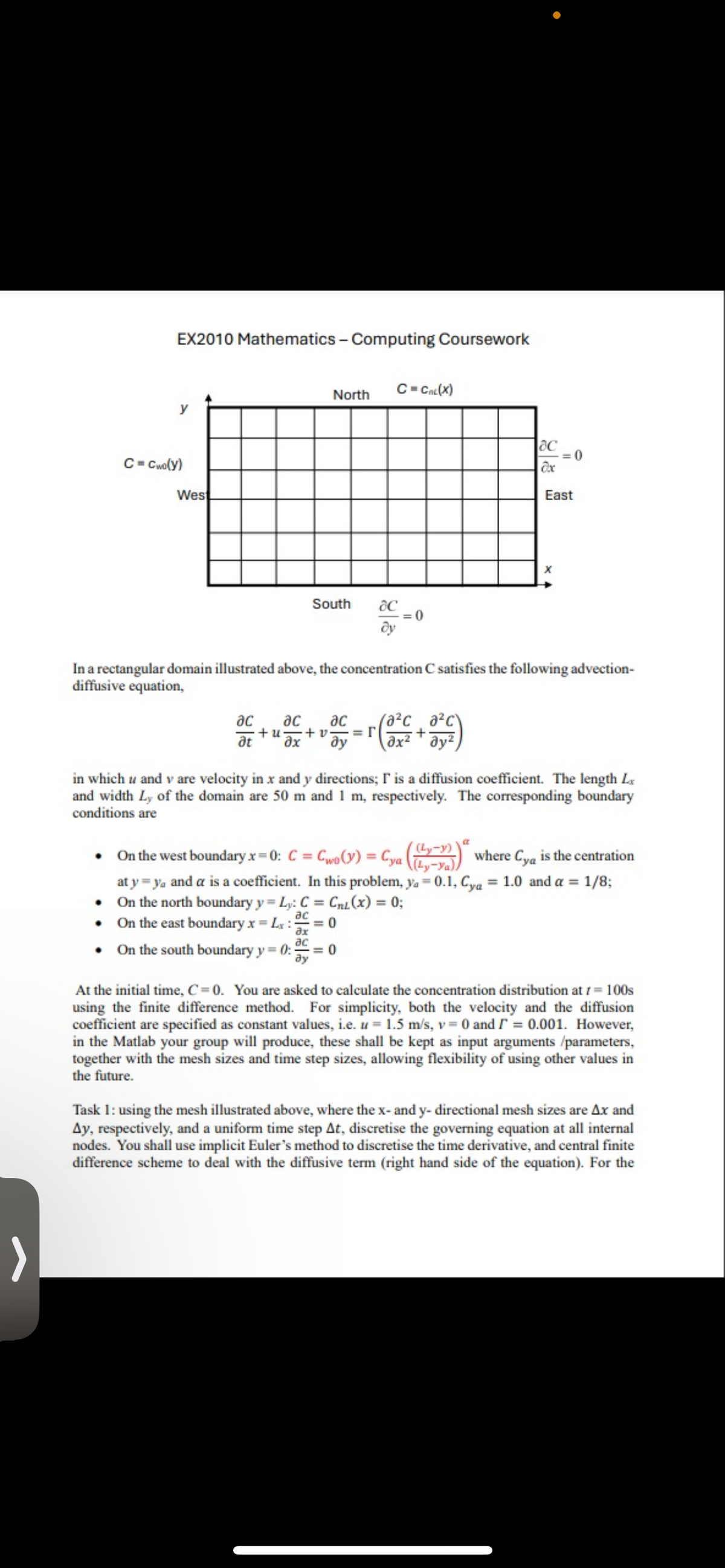EX2010 Mathematics - Computing Coursework C-Cwo(y) West North C=Cnc (X) South дс = 0 By Oc =0 ax East x In a rectangular domain illustrated above, the concentration C satisfies the following advection- diffusive equation, ac ac (a²c a²c\ ас at ax +u+v. =Г ду + in which u and v are velocity in x and y directions; I' is a diffusion coefficient. The length L and width Ly of the domain are 50 m and 1 m, respectively. The corresponding boundary conditions are a On the west boundary x=0: C = Cwo(y) = Cya (y-1)) where Cya is the centration at y ya and a is a coefficient. In this problem, ya=0.1, Cya = 1.0 and α = 1/8; ⚫ On the north boundary y = Ly: C ⚫ On the east boundary x = Lx: = 0 = CnL(x) = 0; ac ax ⚫ On the south boundary y = 0:3 дс = 0 ay At the initial time, C=0. You are asked to calculate the concentration distribution at /= 100s using the finite difference method. For simplicity, both the velocity and the diffusion coefficient are specified as constant values, i.e. u = 1.5 m/s, v = 0 and = 0.001. However, in the Matlab your group will produce, these shall be kept as input arguments /parameters, together with the mesh sizes and time step sizes, allowing flexibility of using other values in the future. Task 1: using the mesh illustrated above, where the x- and y- directional mesh sizes are Ax and Ay, respectively, and a uniform time step At, discretise the governing equation at all internal nodes. You shall use implicit Euler's method to discretise the time derivative, and central finite difference scheme to deal with the diffusive term (right hand side of the equation). For the
EX2010 Mathematics - Computing Coursework C-Cwo(y) West North C=Cnc (X) South дс = 0 By Oc =0 ax East x In a rectangular domain illustrated above, the concentration C satisfies the following advection- diffusive equation, ac ac (a²c a²c\ ас at ax +u+v. =Г ду + in which u and v are velocity in x and y directions; I' is a diffusion coefficient. The length L and width Ly of the domain are 50 m and 1 m, respectively. The corresponding boundary conditions are a On the west boundary x=0: C = Cwo(y) = Cya (y-1)) where Cya is the centration at y ya and a is a coefficient. In this problem, ya=0.1, Cya = 1.0 and α = 1/8; ⚫ On the north boundary y = Ly: C ⚫ On the east boundary x = Lx: = 0 = CnL(x) = 0; ac ax ⚫ On the south boundary y = 0:3 дс = 0 ay At the initial time, C=0. You are asked to calculate the concentration distribution at /= 100s using the finite difference method. For simplicity, both the velocity and the diffusion coefficient are specified as constant values, i.e. u = 1.5 m/s, v = 0 and = 0.001. However, in the Matlab your group will produce, these shall be kept as input arguments /parameters, together with the mesh sizes and time step sizes, allowing flexibility of using other values in the future. Task 1: using the mesh illustrated above, where the x- and y- directional mesh sizes are Ax and Ay, respectively, and a uniform time step At, discretise the governing equation at all internal nodes. You shall use implicit Euler's method to discretise the time derivative, and central finite difference scheme to deal with the diffusive term (right hand side of the equation). For the
Related questions
Question

Transcribed Image Text:EX2010 Mathematics - Computing Coursework
C-Cwo(y)
West
North
C=Cnc (X)
South
дс
= 0
By
Oc
=0
ax
East
x
In a rectangular domain illustrated above, the concentration C satisfies the following advection-
diffusive equation,
ac ac (a²c a²c\
ас
at
ax
+u+v. =Г
ду
+
in which u and v are velocity in x and y directions; I' is a diffusion coefficient. The length L
and width Ly of the domain are 50 m and 1 m, respectively. The corresponding boundary
conditions are
a
On the west boundary x=0: C = Cwo(y) = Cya (y-1)) where Cya is the centration
at y ya and a is a coefficient. In this problem, ya=0.1, Cya = 1.0 and α = 1/8;
⚫ On the north boundary y = Ly: C
⚫ On the east boundary x = Lx: = 0
= CnL(x) = 0;
ac
ax
⚫ On the south boundary y = 0:3
дс
= 0
ay
At the initial time, C=0. You are asked to calculate the concentration distribution at /= 100s
using the finite difference method. For simplicity, both the velocity and the diffusion
coefficient are specified as constant values, i.e. u = 1.5 m/s, v = 0 and = 0.001. However,
in the Matlab your group will produce, these shall be kept as input arguments /parameters,
together with the mesh sizes and time step sizes, allowing flexibility of using other values in
the future.
Task 1: using the mesh illustrated above, where the x- and y- directional mesh sizes are Ax and
Ay, respectively, and a uniform time step At, discretise the governing equation at all internal
nodes. You shall use implicit Euler's method to discretise the time derivative, and central finite
difference scheme to deal with the diffusive term (right hand side of the equation). For the
Expert Solution
This question has been solved!
Explore an expertly crafted, step-by-step solution for a thorough understanding of key concepts.
This is a popular solution!
Trending now
This is a popular solution!
Step by step
Solved in 2 steps with 4 images
